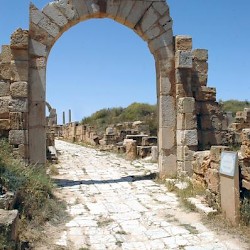
Initially, Rome reached an agreement with some of the Gauls living along France's southern coast, to allow them to pass through on their way to Spain. From then on, it was almost inevitable that the Romans would look to conquer Southern France at some point, as they were in need of a land route between their Italian heartland, and their new rich provinces in Spain. Rome eventually won the war and their main prize was that they ended up in control of much of Spain, including its entire Mediterranean coastline. The war lasted nearly two decades, as Hannibal crossed the River Rhone, then the Alps and took the fight to Italy.

In the year 218 BCE Hannibal led Carthage into war against Rome, following a long and bitter dispute over control of Spain. The big catalyst though were the actions of one of ancient history's most enduring figures: Hannibal Barca. This moved the Roman frontiers closer to Provence, although the formidable barrier of the Alps remained in between. Firstly they extended their territory into Southern Italy, and then they conquered some of the Gauls living in Northern Italy. Rome had gradually become more of an expansionist power. The situation changed in the 3rd century BCE. Gaul was still regarded by Rome as being the land of Barbarians, and they had neither the means nor the will to try to conquer it at this time. Massalia was also allied with Rome, and so directly or indirectly there was significant contact and exchange between the Gauls of Provence and the Romans even as they continued to eye each warily. Much of this was facilitated by the Greek colony of Massalia (modern Marseille) which had long vied with Carthage for dominance of the Western Mediterranean. They were involved in trade networks and would exchange goods across the Mediterranean. The Gauls famously sacked Rome in the year 390 BCE, and their fierce temperament made them greatly feared by the Romans.īut the Gauls of Southern France were not just some group of bandits, going round and stealing from other peoples. The Gauls regularly attacked their neighbours, looking to plunder resources and capture slaves.įrom around the 4th century BCE, one of these neighbours was Rome - at this time still a relatively small city state, but gradually expanding its territory in Italy. In Provence, many were involved in farming, taking advantage of the fertile soils of the Rhone valley. Many Gauls lived in small towns, known as oppida often located on hilltops and were split into hierarchical societies, with a small but powerful ruling aristocracy. Known as Gauls, they were groups who had migrated from Central Europe and inhabited most of modern day France, Belgium and Northern Italy, as well as areas of the Alps. Or, for a more detailed history of Roman Provence, simply continue reading down the page!įrom the middle of the 1st millennium BCE, Provence was mostly inhabited by Celtic tribes. Use the map and links below if you are interested in finding out more about a particular place. These are monuments that we visit on ourĬycling holidays in Provence, and are all within a relatively small area. And in this guide we will be introducing some of the best Roman ruins in Provence, and revealing a little about the stories behind them. Most impressive and extensive of all, in our opinion, are the ancient monuments. Buildings like the Palais des Papes in Avignon or the hilltop castle of Gordes all help to tell the story of the region's history.

But it is also a region whose culture and charm has been influenced by thousands of years of history.Īnd one of the great things about Provence is that it is alive with reminders of past eras. The beautiful villages, the rolling vineyards, the great food and the superb climate are just a few. The foundations of the arch have been found on the Forum Romanum, but nothing is visible.Provence is a fantastic region to visit for many reasons. It appears to have been a single arch, like the later Arch of Titus, flanked by two columns of the Corinthian order. It is mentioned in literary sources, and it is known from a relief on the Arch of Constantine. The Arch of Tiberius is dedicated to Tiberius because in the imperial period only the emperor could celebrate a triumph, so the victory of Germanicus was celebrated with a triumph of Tiberius. The arch spanned the Vicus Jugarius between the Temple of Saturn and the Basilica Julia.

The standards were recovered by Germanicus in 15 or 16 CE. The Arch of Tiberius ( Arcus Tiberii) was erected to celebrate the recovery of the Roman standards that had been lost to Germanic tribes by Varus in 9 CE.


 0 kommentar(er)
0 kommentar(er)
